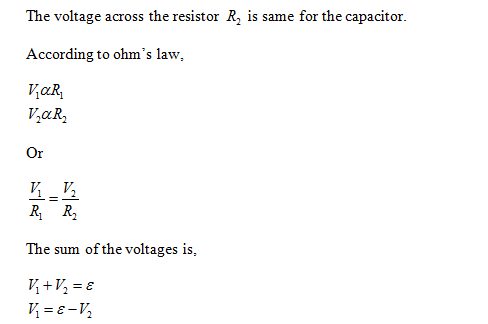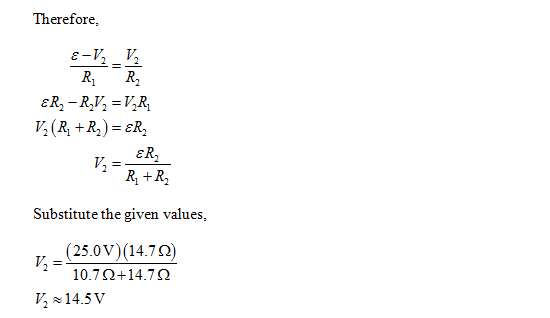R2 R1
Q: In the circuit of the figure & = 3.20 kV, C = 7.80 µF, R1 = R2 = R3 = 1.03 MQ. With Ccompletely…
A:
Q: Chapter 30, Problem 054 In the figure, ε = 118 V, R₁ = 14.9 №, R₂ = 21.3 N, R3 = 35.8 №, and L= 1.90…
A:
Q: In the circuit of the figure = 3.93 kV, C = 8.70 μF, R₁ = R₂ = R3 = 0.800 MQ. With C completely…
A:
Q: A C, A QUESTION 30 In the figure, R=10.0 k2; R₂ = 15.0 k2;C= 0.400 μF; e = 20.0 V. First, the switch…
A: Given:- R1 = 10 kΩ and R2= 15 kΩ C = 0.40μF ε=20 V The circuit as First, the switch is closed for…
Q: For a long period of time the switch S in position "b". At t = 0 s, the switch S moved from position…
A:
Q: Consider the circuit shown. Before the switch is closed, both capacitors are uncharged. V = 12.0 V,…
A: V = 12 volts R1 = 90 Ω R2 = 30 Ω R3 = 60 Ω C1 = 5 × 10-⁶ F C2 = 3×10-⁶ F
Q: A circuit consists of a battery and a resistor R1 (unknown) and has a current I, (also unknown).…
A: The initial circuit consists of a single battery, connected with a single resistor R1. A current I1…
Q: In the circuit of the figure & - 1.33 kV, C - 7.30 µF, R1 = R2 - R3 = 0.830 MQ. With C completely…
A:
Q: The capacitor in the figure below is uncharged for t < 0. If e m f = 9.42 V, R = 59.4 Ω, and C =…
A: Given, emf,ε=9.42V,Resistance,R=59.4ΩCapacitor,C=2.50μF = 2.5×10-6FExpression be…
Q: In the circuit of the figure & = 1.70 kV, C = 9.50 µF. R = R2 = R3 = 0.750 MQ. With C completely…
A:
Q: In the figure, e = 94.8 V, R1 = 7.80 Q, R2 = 27.0 Q, R3 = 30.7 Q, and L = 1.65 H. Immediately after…
A: Since we answer up to three subparts, we will answer the first three. Please resubmit the question…
Q: In the circuit of the figure below, ℰ = 3.0 kV, C = 6.0 μF, R1 = R2 = R3 = 0.72 MΩ. With C…
A: so
Q: 0.364 kg toy car is powered by two C cells (3.00 V total) connected directly to a small DC motor.…
A: GivenMass of toy car(m)=0.364 kgVoltage(V)=3 VEffective energy conversion…
Q: he motor in a toy car is powered by four batteries in series, which produce a total emf of 7.4 V.…
A: Number of batteries = 4Total emf = 7.4 volts Current = 2.9 A Back emf = 2.1 V internal resistance of…
Q: In the circuit of the figure 8 = 1.20 kV, C = 8.00 µF, R1 = R2 = R3 = 0.930 MQ. With C completely…
A:
Q: The switch in the circuit in Fig. P7.16 has been closed for a long time before opening at t = 0.…
A:
Q: In the figure R₁ = 9.69 kQ2, R₂ = 15.9 kQ, C = 0.379 μF, and the ideal battery has emf ε =20.0 V.…
A: Given Data:The resistance of resistor 1 is The resistance of resistor 2 is The capacitance of the…
Q: A 2.20 mF capacitor initially has charge 4.20 mC. You connect it in series with a 4.00 MΩ resistor…
A: Given C=2.20mF=2.20x10-3F qo=4.20mC=4 20x10-3C R=4.00MΩ=4.00x106Ω At t=0 switch is closed.
Q: n the circuit of the figure = 2.80 kV, C = 7.80 µF, R₁ = R₂ = R3 = 1.05 MQ. With C completely…
A: a) i1= 1.78 mA b) i2= 0.889 mA c) i3= 0.889 mA d) i1=1.33 mA e) i2= 1.33 mA f) i3= 0 A…
Q: In the circuit of the figure 8 = 4.10 kV, C = 6.80 μF, R₁ = R₂ = R3 = 0.810 MQ. With C completely…
A:
Q: For the circuit in the figure, at t = 0 the switch S is closed with the capacitor uncharged. If C =…
A:
Q: V 25. In the circuit of Figure P27.25, the switch S has been open for a long time. It is then…
A: a Time constant before switch is closed,Resistance R1 and R2 are in…
Q: Chapter 27, Problem 065 GO In the figure R₁ = 10.9 kN, R₂ 15.0 kN, C = 0.430 µF, and the ideal…
A:
Q: RC Circuit: Dis-Charging We now continue the problem when the switch has been closed for a very long…
A: we have a equivalent resistance RcalculationGIVENR1 = 41 OHMR2 = 25 OHMR3 =90 OHMR4 =…
Q: In the circuit of the figure = 4.00 kV, C = 7.70 μF, R1 = R2 = R3 = 0.930 MΩ. With C completely…
A:
Q: In the circuit of the figure = 3.60 kV, C = 6.70 μF, R₁ = R₂ = R3 = 0.940 MQ. With C completely…
A: Note: As per the guidelines, we can only answer three subparts of a question. Sorry for the…
Q: In the circuit of the figure & = 3.90 kV, C = 7.50 µF, R1 = R2 = R3 = 0.830 M2. With C completely…
A: At t=0 , when the capacitor is uncharged, the potential across it is 0 and it acts as a short, as…
Q: In the figure below, R1 =10.0kΩ, R2 =15.0kΩ, C=0.40μF, and the ideal battery has an emf E=20.0V.…
A:
Q: The current in an RL circuit builds up to one-third of its steady-state value in 4.04 s. Find the…
A:
Q: A light bulb is connected via 2 copper wires of length L = 10 m and diameter d = 0.7 mm with aDC…
A: The problem is asking for the time it takes for the light bulb to start shining after the switch is…
In the figure R1 = 10.7 kΩ, R2 = 14.7 kΩ, C = 0.405 μF, and the ideal battery has emf ε = 25.0 V. First, the switch is closed a long time so that the steady state is reached. Then the switch is opened at time t = 0. What is the current in resistor 2 at t = 3.80 ms?



Trending now
This is a popular solution!
Step by step
Solved in 4 steps with 4 images

- In the figure, suppose the switch has been closed for a length of time sufficiently long for the capacitor to become fully charged. For this circuit, R1 = 12.0 kΩ, R2 = 15.0 kΩ, R3 = 3.000 kΩ, C = 10.0 μF , and emf = 9.00 V. Find (d) the potential differance across R2. (e) the charge on the capacitor.In the figure, & = 134 V, R₁ = 8.500, R₂ = 17.602, R3 = 26.4 02, and L = 2.14 H. Immediately after switch S is closed, what are (a) i₁ and (b) i2? (Let currents in the indicated directions have positive values and currents in the opposite directions have negative values.) A long time later, what are (c) i₁ and (d) i₂? The switch is then reopened. Just then, what are (e) i and (f) i2? A long time later, what are (g) i₁ and (h) i₂? (a) Number (b) Number i (c) Number (d) Number i (e) Number i =8 Units Units Units Units S Units R₁ i₂ {R₂ > > W R₁ > eleIn the circuit of the figure ℰ = 3.30 kV, C = 6.60 μF, R1 = R2 = R3 = 0.740 MΩ. With C completely uncharged, switch S is suddenly closed (at t = 0). At t = 0, what are (a) current i1 in resistor 1, (b) current i2 in resistor 2, and (c) current i3 in resistor 3? At t = ∞ (that is, after many time constants), what are (d)i1, (e)i2, and (f)i3? What is the potential difference V2 across resistor 2 at (g)t = 0 and (h)t = ∞? Answer parts d, e, and f please
- I need help with E, F, G, and H.A fully charged RC circuit is set up using R = 15.0 Ω and C = 8.20 μF with the switch initially open, as shown in the figure. At a certain time after the switch is closed, the current in the circuit has magnitude 3.00 A and the charge on the capacitor is 30.0 μC. At this time, what is the rate at which energy is being stored in the capacitor (in W)?In the circuit below, it is known that R1 = 10 kΩ, R2 = 15 kΩ, and C = 0.4 μF, and a battery with an Emf of 20 Volts. Initially, the connector (switch) is connected for a long time until it reaches a steady state. Then the switch is disconnected/opened at t = 0. What is the current flowing in resistor 2 at t = 4 ms?
- The figure below shows a capacitor, with capacitance C = 45.0 µF, and a resistor, with resistance R = 60.0 kN, connected in series to battery, with & = 15.0 V. The circuit has a switch, which is initially open. R (a) What is the circuit's time constant (in s)? (b) After the switch is closed for one time constant, how much charge (in C) is on the capacitor?In the circuit of the figure ℰ = 3.30 kV, C = 6.60 μF, R1 = R2 = R3 = 0.740 MΩ. With C completely uncharged, switch S is suddenly closed (at t = 0). At t = 0, what are (a) current i1 in resistor 1, (b) current i2 in resistor 2, and (c) current i3 in resistor 3? At t = ∞ (that is, after many time constants), what are (d)i1, (e)i2, and (f)i3? What is the potential difference V2 across resistor 2 at (g)t = 0 and (h)t = ∞? Answer parts a, b, and c please